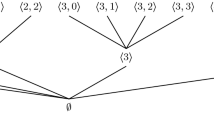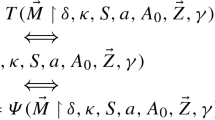Abstract
We show that certain type of tree forcings, including Sacks forcing, increases the covering of the strong measure zero ideal \({{\mathcal {S}}}{{\mathcal {N}}}\). As a consequence, in Sacks model, such covering number is equal to the size of the continuum, which indicates that this covering number is consistently larger than any other classical cardinal invariant of the continuum. Even more, Sacks forcing can be used to force that \(\mathrm {non}({{\mathcal {S}}}{{\mathcal {N}}})<\mathrm {cov}({{\mathcal {S}}}{{\mathcal {N}}})<\mathrm {cof}({{\mathcal {S}}}{{\mathcal {N}}})\), which is the first consistency result where more than two cardinal invariants associated with \({{\mathcal {S}}}{{\mathcal {N}}}\) are pairwise different. Another consequence is that \({{\mathcal {S}}}{{\mathcal {N}}}\subseteq s^0\) in ZFC where \(s^0\) denotes Marczewski’s ideal.



Similar content being viewed by others
Notes
Obvious lower bounds of \(\mathrm{cof}({{\mathcal {S}}}{{\mathcal {N}}})\) are \(\mathrm{cov}({\mathcal {N}})\) and \(\mathrm{cov}({\mathcal {M}})\) because of (SN2) and (SN3), respectively.
Also \(\mathrm{non}({{\mathcal {S}}}{{\mathcal {N}}})\le \mathrm{non}(s^0)\), but \(\mathrm{non}(s^0)={\mathfrak {c}}\) because \([2^\omega ]^{<{\mathfrak {c}}}\subseteq s^0\).
In Yorioka’s original result it is further assumed that \({\mathfrak {d}}=\mathrm{cov}({\mathcal {M}})=\kappa \), but this redundant because \(\mathrm {minadd}\le \mathrm{add}({\mathcal {M}})\le \mathrm{cov}({\mathcal {M}})\le {\mathfrak {d}}\le \mathrm{cof}({\mathcal {M}})\le \mathrm {supcof}\), as pointed out in the paragraph preceding the theorem.
A poset \({\mathbb {P}}\) is strongly \(\omega ^\omega \)-bounding if for any \(p\in {\mathbb {P}}\) and any \({\mathbb {P}}\)-name \({\dot{x}}\) of a function from \(\omega \) into the ground model, there are a function f from \(\omega \) into the finite sets and some \(q\le p\) that forces \({\dot{x}}(n)\in f(n)\) for any \(n<\omega \).
References
Bartoszyński, T., Judah, H.: Set Theory: On the Structure of the Real Line. A K Peters, Wellesley (1995)
Bartoszyński, T., Shelah, S.: Strongly meager and strong measure zero sets. Arch. Math. Logic 41(3), 245–250 (2002). https://doi.org/10.1007/s001530000068
Blass, A.: Combinatorial cardinal characteristics of the continuum. In: Handbook of Set Theory, vols. 1, 2, 3. Springer, Dordrecht, pp. 395–489 (2010). https://doi.org/10.1007/978-1-4020-5764-9_7
Brendle, J.: Larger cardinals in Cichoń’s diagram. J. Symb. Log. 56(3), 795–810 (1991). https://doi.org/10.2307/2275049
Brendle, J., Cardona, M.A., Mejía, D.A.: Filter–linkedness and its effect on preservation of cardinal characteristics. Ann. Pure Appl. Log. 171(1), 102856 (2021). https://doi.org/10.1016/j.apal.2020.102856. arXiv:1809.05004
Cardona, M.A.: On cardinal characteristics associated with the strong measure zero ideal. Fundam. Math. (2021). arXiv:2003.07066 (accepted)
Cardona, M.A., Mejía, D.A.: On cardinal characteristics of Yorioka ideals. Math. Log. Q. 65(2), 170–199 (2019). https://doi.org/10.1002/malq.201800034. https://onlinelibrary.wiley.com/doi/abs/10.1002/malq.201800034
Carlson, T.J.: Strong measure zero and strongly meager sets. Proc. Am. Math. Soc. 118(2), 577–586 (1993). https://doi.org/10.2307/2160341
Goldstern, M.: Tools for your forcing construction. In: Set Theory of the Reals (Ramat Gan, 1991).Israel Math. Conf. Proc., vol. 6. Bar-Ilan Univ., Ramat Gan, pp. 305–360 (1993)
Goldstern, M., Judah, H., Shelah, S.: Strong measure zero sets without Cohen reals. J. Symb. Log. 58(4), 1323–1341 (1993). https://doi.org/10.2307/2275146
Goldstern, M., Shelah, S.: Many simple cardinal invariants. Arch. Math. Logic 32(3), 203–221 (1993). https://doi.org/10.1007/BF01375552.. arXiv:math/9205208
Judah, H., Miller, A.W., Shelah, S.: Sacks forcing, Laver forcing, and Martin’s axiom. Arch. Math. Log. 31(3), 145–161 (1992). https://doi.org/10.1007/BF01269943
Judah, H., Shelah, S.: The Kunen–Miller chart (Lebesgue measure, the Baire property, Laver reals and preservation theorems for forcing). J. Symb. Log. 55(3), 909–927 (1990). https://doi.org/10.2307/2274464
Klausner, L.D., Mejía, D.A.: Many different uniformity numbers of Yorioka ideals. Arch. Math. Logic (2021). arXiv:1805.11005 (accepted)
Laver, R.: On the consistency of Borel’s conjecture. Acta Math. 137(3–4), 151–169 (1976)
Marczewski, E.: Sur une classe de fonctions de W. Sierpiński et la classe correspondante d’ensembles. Fund. Math. 24, 17–34 (1935)
Miller, A.W.: Some properties of measure and category. Trans. Am. Math. Soc. 266(1), 93–114 (1981). https://doi.org/10.2307/1998389
Montoya, D.C.: Some cardinal invariants of the generalized Baire spaces. PhD thesis, University of Vienna (2017)
Osuga, N.: The cardinal invariants of certain ideals related to the strong measure zero ideal. Kyōto Daigaku Sūrikaiseki Kenkyūsho Kōkyūroku 1619, 83–90 (2008)
Pawlikowski, J.: Finite support iteration and strong measure zero sets. J. Symb. Log. 55(2), 674–677 (1990). https://doi.org/10.2307/2274657
Rosłanowski, A., Shelah, S.: Norms on possibilities. I. Forcing with trees and creatures. Mem. Am. Math. Soc. 141(671), xii+167 (1999). https://doi.org/10.1090/memo/0671
Shelah, S.: Proper and Improper Forcing, vol. 5. Cambridge University Press, Cambridge (2017)
Yorioka, T.: The cofinality of the strong measure zero ideal. J. Symb. Log. 67(4), 1373–1384 (2002). https://doi.org/10.2178/jsl/1190150290
Author information
Authors and Affiliations
Corresponding author
Additional information
Publisher's Note
Springer Nature remains neutral with regard to jurisdictional claims in published maps and institutional affiliations.
This work was supported by the Austrian Science Fund (FWF) P30666 and the DOC Fellowship of the Austrian Academy of Sciences at the Institute of Discrete Mathematics and Geometry, TU Wien (first author), the Grant-in-Aid for Early Career Scientists 18K13448, Japan Society for the Promotion of Science (second author), and by the Grant No. IN202010, Dirección de Tecnología e Investigación, Institución Universitaria Pascual Bravo (second and third authors)
Rights and permissions
About this article
Cite this article
Cardona, M.A., Mejía, D.A. & Rivera-Madrid, I.E. The covering number of the strong measure zero ideal can be above almost everything else. Arch. Math. Logic 61, 599–610 (2022). https://doi.org/10.1007/s00153-021-00808-0
Received:
Accepted:
Published:
Issue Date:
DOI: https://doi.org/10.1007/s00153-021-00808-0




